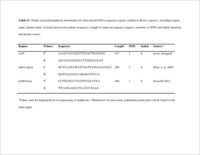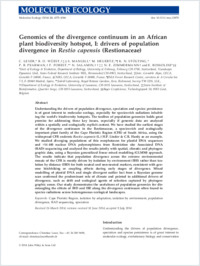Genomics of the divergence continuum in an African plant biodiversity hotspot, I: drivers of population divergence in Restio capensis (Restionaceae)
Université de Fribourg
- Lexer, Christian Unit of Ecology & Evolution, Department of Biology, University of Fribourg, Switzerland
- Wüest, R. O. Landscape Dynamics Unit, Swiss Federal Research Institute WSL, Birmensdorf, Switzerland - Univ. Grenoble Alpes, LECA, Grenoble, France - CNRS, LECA, Grenoble, France
- Mangili, Sophia Unit of Ecology & Evolution, Department of Biology, University of Fribourg, Switzerland
- Heuertz, Myriam Unit of Ecology & Evolution, Department of Biology, University of Fribourg, Switzerland - INIA Forest Research Centre, Madrid, Spain
- Stölting, Kai N. Unit of Ecology & Evolution, Department of Biology, University of Fribourg, Switzerland
- Pearman, Peter B. Landscape Dynamics Unit, Swiss Federal Research Institute WSL, Birmensdorf, Switzerland
- Forest, Félix Jodrell Laboratory, Royal Botanic Gardens, Kew, Richmond, Surrey, U.K
- Salamin, Nicolas Department of Ecology & Evolution, University of Lausanne, Switzerland - Swiss Institute of Bioinformatics, Lausanne, Switzerland
- Zimmermann, Niklaus E. Landscape Dynamics Unit, Swiss Federal Research Institute WSL, Birmensdorf, Switzerland
- Bossolini, Eligio Unit of Ecology & Evolution, Department of Biology, University of Fribourg, Switzerland - Bayer CropScience, Gent, Belgium
-
01.09.2014
Published in:
- Molecular Ecology. - 2014, vol. 23, no. 17, p. 4373–4386
English
Understanding the drivers of population divergence, speciation and species persistence is of great interest to molecular ecology, especially for species-rich radiations inhabiting the world's biodiversity hotspots. The toolbox of population genomics holds great promise for addressing these key issues, especially if genomic data are analysed within a spatially and ecologically explicit context. We have studied the earliest stages of the divergence continuum in the Restionaceae, a species-rich and ecologically important plant family of the Cape Floristic Region (CFR) of South Africa, using the widespread CFR endemic Restio capensis (L.) H.P. Linder & C.R. Hardy as an example. We studied diverging populations of this morphotaxon for plastid DNA sequences and >14 400 nuclear DNA polymorphisms from Restriction site Associated DNA (RAD) sequencing and analysed the results jointly with spatial, climatic and phytogeographic data, using a Bayesian generalized linear mixed modelling (GLMM) approach. The results indicate that population divergence across the extreme environmental mosaic of the CFR is mostly driven by isolation by environment (IBE) rather than isolation by distance (IBD) for both neutral and non-neutral markers, consistent with genome hitchhiking or coupling effects during early stages of divergence. Mixed modelling of plastid DNA and single divergent outlier loci from a Bayesian genome scan confirmed the predominant role of climate and pointed to additional drivers of divergence, such as drift and ecological agents of selection captured by phytogeographic zones. Our study demonstrates the usefulness of population genomics for disentangling the effects of IBD and IBE along the divergence continuum often found in species radiations across heterogeneous ecological landscapes.
- Faculty
- Faculté des sciences et de médecine
- Department
- Département de Biologie
- Language
-
- English
- Classification
- Biological sciences
- License
- License undefined
- Identifiers
-
- RERO DOC 211370
- DOI 10.1111/mec.12870
- Persistent URL
- https://sonar.ch/global/documents/303819
Other files
Statistics
Document views: 41
File downloads:
- lex_gdc_sm3.pdf: 75
- lex_gdc_sm4.txt: 17
- lex_gdc_sm5.txt: 22
- lex_gdc_sm6.txt: 21
- lex_gdc_sm7.txt: 34
- lex_gdc.pdf: 117


